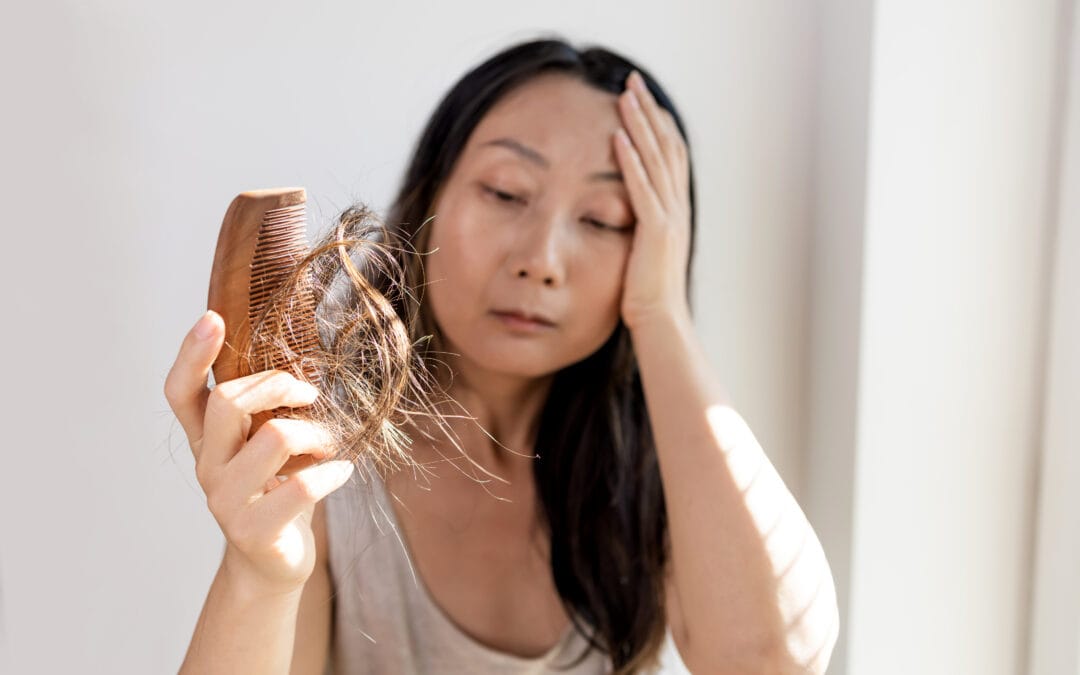CPAP therapy is a necessary treatment for those with sleep apnea. In general, the benefits of CPAP therapy far outweigh any of the challenges or side effects that may be experienced by those who use a CPAP or BiPAP machine.
CPAP therapy offers significant benefits, especially if you are someone who has struggled with daytime sleepiness or tiredness, mood swings, insomnia, depression, fatigue, and obstructed breathing while you’re sleeping. Your sleep apnea condition can be life-threatening, so you must continue using your CPAP machine.
If you do CPAP therapy and are experiencing hair loss associated with using your CPAP machine, we are here to help offer you some simple ways to reduce hair loss and protect your hair while using the vital CPAP therapy you need.
Causes of CPAP Hair Loss
Various things, including genetics, can cause hair loss. Regardless of the cause, hair loss can lead to confidence issues and impact our day-to-day lives. If you’re experiencing hair loss that you believe is associated with your CPAP, there are some easy ways to protect your hair while still receiving the full benefits of your CPAP therapy.
In general, the increased oxygen levels in your body that you receive from your CPAP therapy are highly beneficial and will likely increase hair growth. However, if you believe your hair loss could be directly related to the friction from your CPAP headgear straps, here are some simple solutions to help protect your hair.
Ways to Protect Your Hair While Using Your CPAP
Your CPAP therapy is vital to your health and alleviating your sleep apnea. We also understand that minimizing common problems is essential, and here are some tips to help reduce hair loss so you can receive the maximum benefits of regularly using your CPAP or BiPAP machine.
#1. Take Extra Care of Your Hair
You may already take great care of your hair. Even if you do, there may be some simple things that you can adjust to help reduce hair loss. Taking extra care of your hair could include:
- Scalp massages before bed
- Taking supplements, such as biotin, to help stimulate keratin production
- Avoid over-washing, over-conditioning, or over-cutting your hair.
If you have longer hair, putting it in a ponytail using a silk scrunchie or a small tight bun before wearing your CPAP headgear may help reduce the friction that causes CPAP hair loss.
Another option is to change your hairstyle. This will make your hair easier to care for and ensure your CPAP headgear is more comfortable and fits better. You could also change how you style your hair to help alleviate hair dents from the CPAP straps.
#2. Wear a Hair Protector
Another possible solution is to cover your hair with a sleep cap, silk bonnet, scarf, or skull cap to help reduce friction from your CPAP straps. Other options include wearing a bandanna, a soft beanie, or a helmet liner.
You can use whatever is comfortable as long as you place a barrier between your hair and the CPAP straps. This method will help protect even the most brittle fine hair from damage. However, if you can’t tolerate something on your head while sleeping due to claustrophobia, sensory issues, or temperature fluctuations, there are still other options.
#3. Try an Alternate CPAP Mask
CPAP masks come in various styles, and sometimes, trying an entirely new style or rotating between different masks and headgear is the perfect solution for many people.
The best CPAP mask and headgear are the most comfortable for you. Try an alternative mask until you find one that doesn’t move around as much and does not need to be very tight.
You can also rotate different masks and headgear so that the straps do not rub in the same place every night. This can relieve your hair from having the straps in the same area consistently and still allow you to receive your CPAP therapy.
#4. Use Extra Padding
You can ask your sleep specialist about using extra padding on your headgear so that it doesn’t cause friction on your hair or irritate your face while you’re sleeping. If you cover up the straps at the top with extra padding, it can help to reduce hair loss. It also helps eliminate the possibility of your hair getting tangled in buckles or velcro.
An easy DIY solution is to use soft material you may have at home, such as a rolled-up towel or washcloth, on the straps. If you want a ready-made solution, you can purchase CPAP mask strap pads that are easy to install and maintain. Remember to wash your pads and keep them clean.
#5. Opt For a No-Headgear Mask
For patients who can breathe exclusively through their nose, a no-headgear CPAP mask may be an option. Several options, including nasal pillows, allow patients to receive CPAP therapy without using any or minimal headgear.
The most important thing is that you do not stop your CPAP therapy and search for a solution that works best for you.
DreamZz Sleep Center Is Here to Help You Find the Best CPAP Treatment Solutions
Receiving treatment for sleep apnea is crucial to your health and quality of life. DreamZz Sleep Center specializes in comprehensive sleep care to ensure our patients get a restful night’s sleep and maintain their quality of life and overall health.
Our sleep specialist and a home sleep test can help you determine the best treatment. We will create a customized therapy plan for you and ensure you receive everything you need for a comfortable, restful night’s sleep. Whether it is a CPAP or BiPap machine or a nasal pillow to help you with insomnia, obstructive sleep apnea, tiredness or sleepiness, snoring, or trouble sleeping, we provide CPAP machines and accessories you need to get a restful night’s sleep.
Contact us to book a consultation today, and we will get you on the road to better health and sleep!


Recent Comments